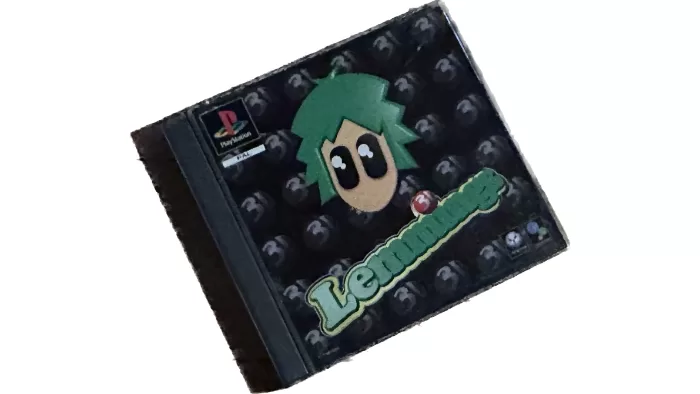
“Remember early 3D games, weren’t they FANTASTIC!” said… well, very few people, actually. 3D Lemmings is an absolute object lesson in how to not take a beloved series into the third dimension.
In Retro Game Of The Week I pull a game from my collection and write about why it’s important or interesting. Or in some cases, badly dated and rubbish.
DMA Design’s Lemmings is an absolute classic retro game, one of the absolute best puzzle games of all time, no question. I will not hear anything against it.
Part of the charm of Lemmings was its simplicity; move a cursor around, guide your little pixellated chums to the exit, repeat. It worked well from day one, and it was a recipe that meant it could be ported to just about every platform going after its Amiga debut.
Not just Sega, mind. Also available on well, just about anything, including (astonishingly) the Apple II GS.
While I won’t hear a word against Lemmings, it does have the classic puzzle game problem. DMA Design got it pretty much spot on for the original game, with lessening results for the sequels and add-ons as time went by.
Which brings us to the late 1990s, when 2D games of the Lemmings style were firmly out of fashion. 3D was everything, buoyed by the astonishing success of Sony’s PlayStation. If you weren’t 3D, the thinking went, you were yesterday’s news and of no value.
That thinking, I hasten to add, was absolutely wrong, but it drive a lot of 3D content that was, shall we say, less than stellar.
‘Nuff said
Which brings us to 3D Lemmings. By the mid 1990s, DMA Design had moved onto other fields with some sort of (checks notes) crime simulator 2D top-down game? Really? I wonder whatever happened to them after that?
But while Lemmings had Scottish DNA (fun fact: There are statues in Dundee, Scotland of the Lemmings, and one day I will make it there to see them myself… one day…), the rights remained with the publisher Psygnosis.
Pysgnosis was by this stage a wholly owned entity of Sony, and that meant that 3D graphics style games for the PlayStation were very much on the menu — though it’s worth noting that this week’s retro game also has Sega Saturn and DOS ports as well.
That brings in developers Clockwork Games, probably most famous for… well, this actually. They got the job of bringing the Lemmings into the third dimension without losing that addictive puzzle style.
They certainly tried… but I would strongly argue they failed, and with the benefit of hindsight, it’s pretty easy to see where. Some smart decisions were made, dropping most of the very gimmicky Lemmings from the sequels in favour of a set that’s mostly the classics — your diggers, builders, blockers and so on — as well as a new Lemming that acts as a 90 degree turner for your Lemmings. All good so far.
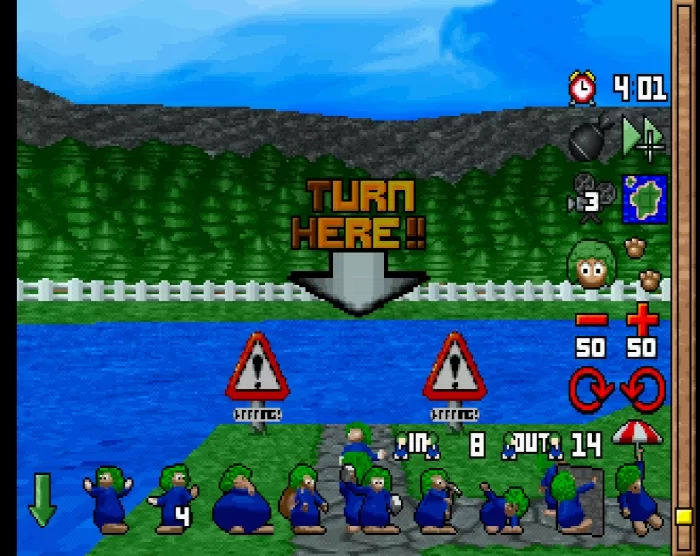
You’re not the boss of me. Sure, all the Lemmings will drown, but still, I do what I want.
The problem with 3D Lemmings is that it dates from an era where everyone was really still experimenting with how you might implement a 3D interface AND it had to work with the original, no-dual-stick-for-you PlayStation controller.
What this means (deep breath) is that you get a weird mix of fixed cameras you can move to and buttons to turn the camera axis horizontally (but not vertically) and sliders to control height and then face buttons to move in and out and left and right and on top of all of that a virtual Lemming mode that puts you in the eyes of a given Lemming for areas of the game where you cannot move the camera either due to design or the way the world works so that you can accurately set up a blocker, bomber, digger or whatever else might be needed to guide your hapless Lemmings home.
Phew. Breathe out. That was a hell of a paragraph to write, and probably not that much fun to read, right?
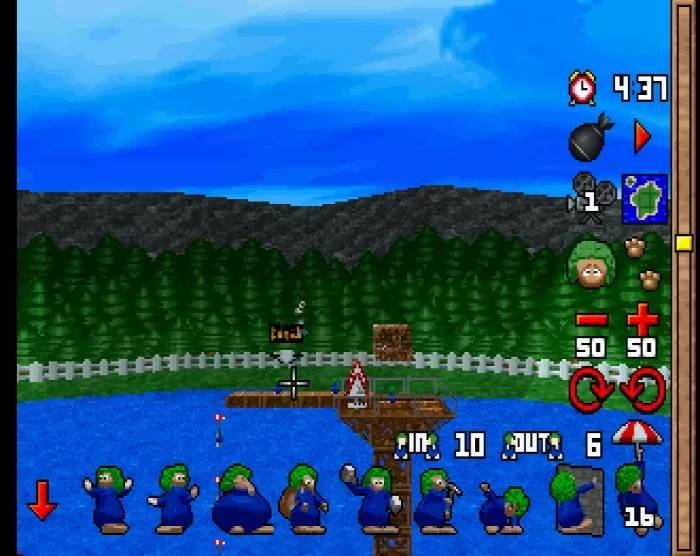
Fancy 3D visuals don’t mean much if you still have to zoom out this far to plan.
But it’s all true, because you do have to manage all those disparate controls in effective real time in order to make progress in 3D Lemmings.
While (as with the classic Lemmings) you can pause to take stock and move the camera around at any time, this still involves fighting those controls, finding the right angles and setting your Lemmings in motion when you do. It’s infuriating to miss a move you need to make only to get it wrong and have to start a level again. The replay of your moves is a nice conciliatory step here… but it’s not enough.
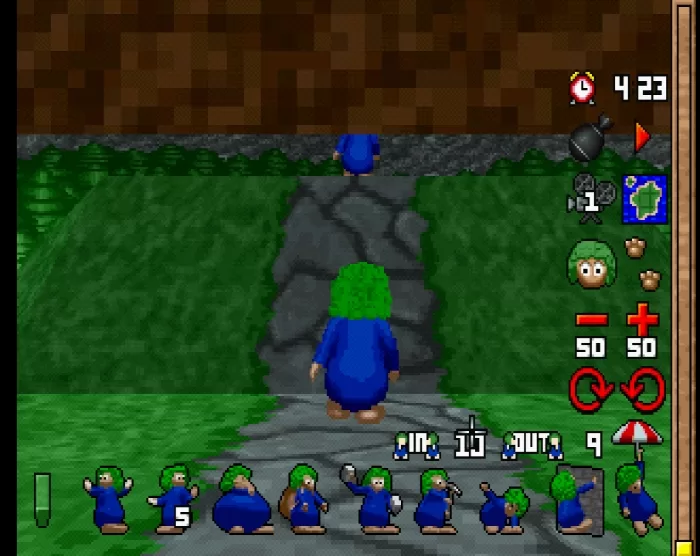
Virtual Lemmings mode, also possibly Sir Mix-A-Lot’s preferred way to play.
Lemmings games should be about teasing your brain to work out the solution and then making it happen in effective real time, not enraging your cerebellum because you’re fighting the camera controls all the time. It’s also disappointing, because it’s not that hard to see how with a modern dual stick setup, even on a console, you could perhaps make this concept work a lot more elegantly, leaving you with more scope to actually enjoy the game’s puzzles.
Still, 3D was it in the mid 1990s, and the gaming press was very much on board with this. I’d argue that this is one of those early 3D games where the visuals haven’t aged particularly well, especially given the cute nature of those original pixel art Lemmings, but GameSpot’s review at the time argued that “3D Lemmings is a must-buy” and that the “graphics in 3D Lemmings are colorful and eye pleasing”.
Odd note: It was apparently “Lemmings 3D” in the USA and “3D Lemmings” elsewhere, including here in Australia. I wonder why?
Getting back on track, IGN had similar thoughts, though in hindsight I do find this sentence kind of amusing:
“The graphics are nice enough, with the simple, colorful backgrounds and detailed structures, but compared to something like Jumping Flash! it looks a little barren.”
Well, OK then.
How to play 3D Lemmings (PSOne) now
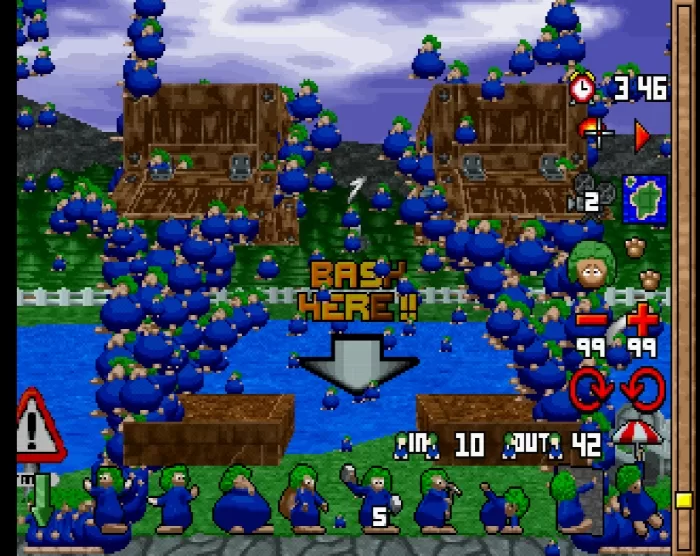
Nuking Lemmings is satisfying, but it’s somewhat reduced when they just break up into thousands of micro Lemmings.
If I nuke the Lemmings, I WANT THEM DEAD, OK?
I rather foolishly purchased Lemmings 3D at full price back in the day, and that still hurts, because I really don’t rate it, just in case that wasn’t clear. It’s an interesting study on how developers tried to get 3D interfaces to work in a game-friendly way, for sure, but that’s about all.
If you want a copy for the PlayStation One, there’s a lot of price variance, with copies on eBay actually selling for anywhere between $20 to $120, not including shipping. That’s likely due to the fact that in some territories it came in an jewel case (like my copy did) while in other areas there was also a “longbox” style version.
Of course, you can pay a lot more than that, because eBay’s like that. Don’t be a Lemming. Do your research.
Bonus: You thought I was kidding about the Apple IIGS version, right?
